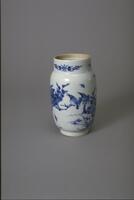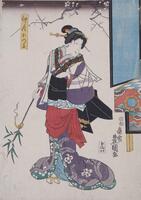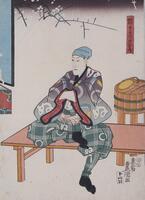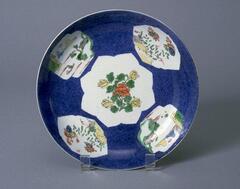7 UMMA Objects
7 UMMA Objects
![Many white porcelain bottles of this type were produced at Bunwon-ri in the 19th century. One side of its body is decorated with a spray of plum blossom, with the stem and flowers rendered in underglaze iron brown and cobalt blue, respectively. The relatively vivid colors of iron and cobalt colors made the decorations highly effective. The entire foot was glazed, while the foot rim retains traces of fine sand spurs. The precipitation of ash deposits on one side has produced pale green spots. However, this is a high-grade object with transparent and well-fused glaze.<br />
[Korean Collection, University of Michigan Museum of Art (2014) p.180] Many white porcelain bottles of this type were produced at Bunwon-ri in the 19th century. One side of its body is decorated with a spray of plum blossom, with the stem and flowers rendered in underglaze iron brown and cobalt blue, respectively. The relatively vivid colors of iron and cobalt colors made the decorations highly effective. The entire foot was glazed, while the foot rim retains traces of fine sand spurs. The precipitation of ash deposits on one side has produced pale green spots. However, this is a high-grade object with transparent and well-fused glaze.<br />
[Korean Collection, University of Michigan Museum of Art (2014) p.180]](/media/W1siZiIsIjIwMjIvMDkvMjQvOWltazR0ZHVoNV9kZWZhdWx0LmpwZyJdLFsicCIsInRodW1iIiwiMjQweDIwMCJdXQ?sha=d577b9f60161a4da)
Korean (Korean (culture or style))
Wine bottle with plum branch design
1850 – 1899
Gift of Bruce and Inta Hasenkamp and Museum purchase made possible by Elder and Mrs. Sang-Yong Nam
2004/1.275

Maruyama Ōkyo
Bird on a Plum Branch
1750 – 1799
Museum purchase made possible by the Margaret Watson Parker Art Collection Fund
1964/1.105

Utagawa Kuniyoshi (Japanese (culture or style))
Sugawara no Michizane and the Secrets of Calligraphy: Bandō Mitsugorō IV as Fujiwara Shihei and Seki Sanjūrō III as Umeōmaru
1850
Gift of Sharlynn and Andrew Circo, in memory of Sotokichi Katsuizumi
2011/2.199.2

Chinese (Chinese (culture or style))
Jar
1628 – 1644
Museum purchase made possible by the Margaret Watson Parker Art Collection Fund
1975/1.82

Utagawa Kunisada (Japanese (culture or style))
Celebratory Soga for the New Year: Azuma Tōzō V as the Maid Otsuru
1848
Gift of Sharlynn and Andrew Circo, in memory of Sotokichi Katsuizumi
2011/2.191.1

Utagawa Kunisada (Japanese (culture or style))
Celebratory Soga for the New Year: Ichikawa Danjūrō VIII as Sweets Seller Totsukeihei
1848
Gift of Sharlynn and Andrew Circo, in memory of Sotokichi Katsuizumi
2011/2.191.3

Chinese (Chinese (culture or style))
Dish
1700 – 1722
Gift of the Estate of Hobart Taylor, Jr.
1982/1.213
Loading…
